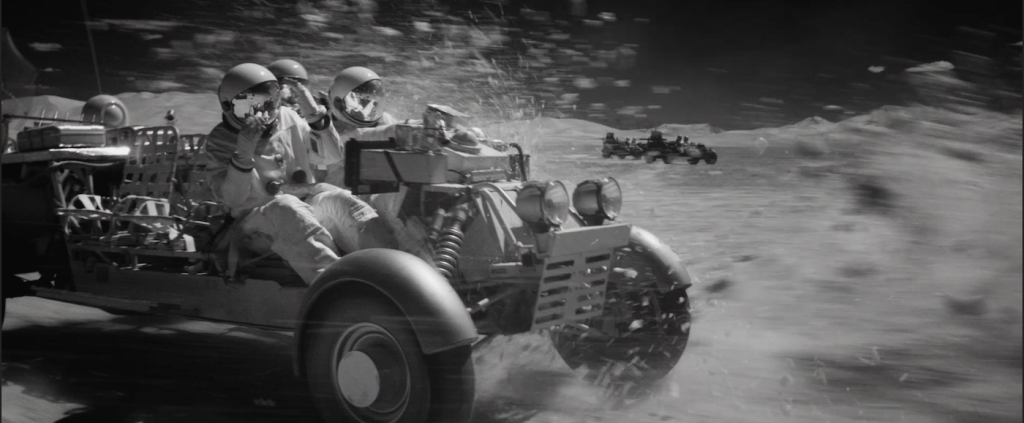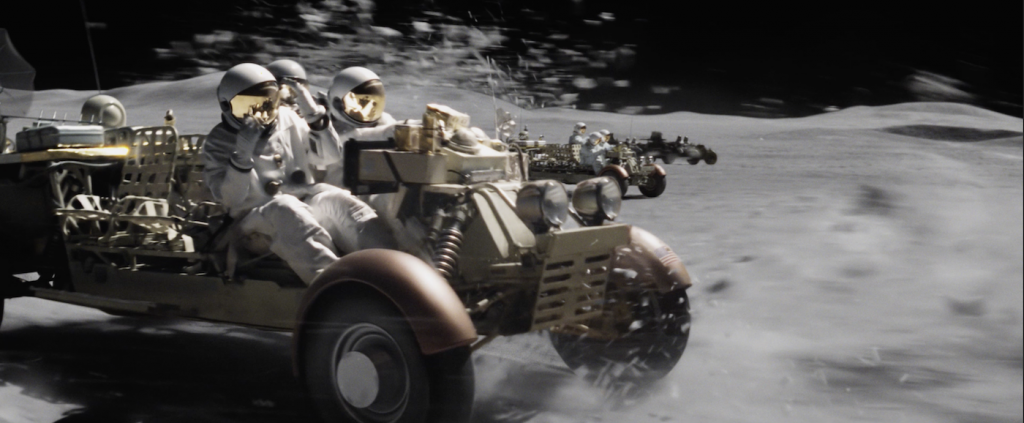How the VFX Team Behind Ad Astra Achieved Deep Space
How do you conceptualize a future that feels familiar yet doesn’t exist? For, visual effects supervisor Allen Maris and the entire crew detailing director James Gray’s vision behind Ad Astra, that question became a guiding theme.
The 20th Century Fox sci-fi thriller puts Brad Pitt in a spacesuit and asks him to save mankind. Not from a zombie inducing lethal virus but from a threat deep in our solar system. The allegory picks up with astronaut expert Major Roy McBride (Pitt) climbing down a ladder of an alien life seeking antenna that reaches far into Earth’s outermost atmosphere when a sudden power surge puts his life in danger. The entire sequence became an early hurdle for visual effects.
“We started thinking about the opening sequence immediately,” says Maris. “We talked a lot about the mechanics of the tower, how it should look and its height. Ultimately, we decided on an antenna instead of something like a space elevator with the idea that since we’re in the future, new materials have been created that can withstand the forces of nature and the compression.”
The scene was blocked from script to storyboard and then previs/postvis vendor Halon brought it to life for Gray, Maris, cinematographer Hoyte Van Hoytema and production designer Kevin Thompson to detail what parts would be set builds and what shots were going to be visual effects. Roughly 25 feet of the antenna and 15 feet of the ladder McBride clings to were constructed as practical sets. From there, visual effects took over to complete the massive structure and atmosphere.
When McBride jumps, plummeting back down to Earth, visual effects took shots from a 13,000-foot skydive over San Louis Obispo County and replaced the backgrounds with the correct altitude. VFX also digitally created all the wide shots of the death-defying fall.
Back on Earth, McBride learns the incident was not an accident but part of a string of catastrophes taking place across the blue planet. The cause: cosmic rays from an explosion near Neptune believed to be from The Lima Project, a mission launched 16 years ago. The commander of the project is McBride’s father, Clifford (Tommy Lee Jones) who’s been missing ever since. With no way to stop the electrical surges, U.S. intelligence asks for McBride’s help in sending a message to deep space. The only way of doing so is to travel to Mars via the moon to a communications outpost that hasn’t been affected.
Even with a large story scope, Maris, who’s worked on VFX-driven films like The Chronicles of Riddick, Godzilla and Prometheus, notes the director “had a much smaller vision” in terms of its effects saying, “James didn’t want a bunch of visual effects for visual effects sake or a glossy Hollywood production. Ad Astra was about the story and its characters.”
Visuals were grounded through exploratory research from places like NASA and Jet Propulsion Laboratory. The technology that found its way on screen stemmed from the same ‘60s and ‘70s science but with a futuristic touch. Thompson’s production design aimed to be naturalistic, and when it came to constructing its spaceships, organized chaos became the calling. Each ship was detailed so that every single thing down to the buttons had a functional purpose.
For Ad Astra’s rocket launches that take place on Earth, the moon and Mars visual effects studied NASA footage from the late-‘60s Saturn V launches in order to replicate atmosphere and intensity. They also used the footage to mimic the same camera angles, and when taking off from the moon and Mars, they simulated the same gravity found on both lunar rocks – making sure to detail that the proper amount of smoke, fire, and debris filled the air. “The moon has 1/6 the gravity of Earth and we took that into consideration during our simulations,” says Maris. “You can also see in the NASA footage when Apollo lifts off from the moon, it’s a quick explosion that burns off quickly and there’s no traditional arc. It flies out in a linear pathway. We took all that into consideration during our planning.”
Landing on the moon McBride strolls through the lunar terminal that feels all too familiar because of the corporate brands that line the airport. In fact, the moon has been overrun by the private industry, different governments, and even pirates, who pose an imminent threat when McBride tries to travel via rover from the lunar airport to a U.S. facility on the other side of the moon.
To capture the epic chase sequence production went to the Dumont Dunes in the Mojave Desert where Van Hoytema shot in infrared to turn the desert sand and blue sky into the dark blackness and milky white landscapes found on the moon. The collaborative effort between the camera and visual effects used new technology to pull off the look. For most of the visuals, Van Hoytema used Arriflex 435 cameras and Camtec “Astra” Master Primes, lenses specifically developed for the movie between the cinematographer and Camtec. The lenses have a “substantial flarey texture than Vintage Ultra Primes” with a shallower depth of field than a traditional T1.3 according to Camtec.
During the chase, both a film and an ARRI Alexa digital camera were mounted on a 3ality stereo rig with the digital camera shooting infrared. In post, visual effects extracted the color information from the film camera to composite with the IR footage to create the high contrast look of the moon.
In our first test in post, we realized it wasn’t going to be as simple of a process we hoped when shooting. We ended up needing to replace about 25 feet of the mid-ground from the rovers and some of the foreground near the actors,” says Maris. “Once we accomplished that, we finished the look by extending the world around them.”




World-building was an essential part of the visual effects pipeline including Mars exteriors, space travel, and Neptune, the bright azure blue planet with 5 rings. While most of the Mars scenes took place underground visual effects referenced recently taken photos from JPL to give the planet a touch of magenta blue to its skyline. “The images they captured were incredible. The sun gives Mars this blue halation making it not as red as we think it is,” says Maris.

Visual effects also kept its camera moves aligned with a subjective point of view while limiting what Maris called “God’s POV shots.” In detailing Neptune, VFX wanted to be as scientific as possible in terms of its size and the distance between each ring. “When we researched the planet we found out the small ring is between 3,500 and 5,000 km (2,174 – 3106mi) wide. That’s huge. Knowing that we had to adjust the location between McBride’s ship and the Lima Project ship otherwise the time it took to travel from one to other would not make any sense,” says Maris. “Whatever we did, we tried to be scientifically authentic. If our job is not done well people will not immediately buy into it.”
Ad Astra is in theaters today.
Featured image: Brad Pitt stars in ‘Ad Astra.’ Credit: Francois Duhamel. Copyright Twentieth Century Fox



